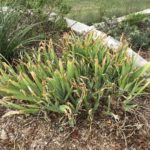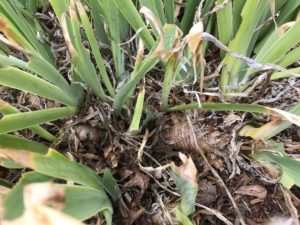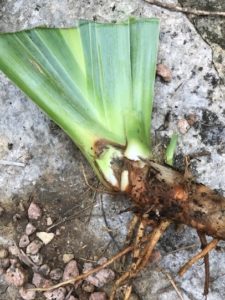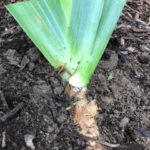Iris Dividing is Easy
Now that temperatures are out of the 100+ category, it’s time to get out there and begin dividing iris. Irises have no issues with being divided, making them the perfect plant to spread around your yard or share with neighbors. Here is how to divide overcrowded clumps. You’ll need a pair of gloves, a digging fork, a spade, hand pruners, and a bucket to store your extra rhizomes.
How to Identify Overcrowding

You may need a knife or pruners to separate rhizomes.
You can tell that your irises are crowded when the larger rhizomes start to push above the ground in search of more space. Use a digging fork or spade to remove the entire clump. You’ll be able to untangle many of the rhizomes with your hands, but if they are especially tight, use a pair of hand pruners or a knife to separate them.
As you separate, inspect the rhizomes, eliminating any that are decaying or soft. Cut back the foliage to 4-6 inches from the rhizome to promote focus on setting roots, rather than sustaining the foliage. New foliage will emerge in the spring, so don’t worry! Use a bucket to store the keepers.
 Overcrowded rhizomes push above ground. |
 Trim foliage back to about six inches. |
Don’t Plant too Deep

Plant iris on top of soil and then cover with 1/4 inches of mulch.
Central Texas summer heat can be hard on the rhizomes, so it’s generally recommended that you plant them about ¼ inch below the surface of the soil. Alternatively, you can plant them directly on top of soil and add about ¼ inch of mulch. Don’t plant them too deep. Iris need light on their rhizomes to set blooms for the next year.
It’s not necessary to add any fertilizer as irises don’t require much support other than from mother nature. But, if your soil tests show the need, you can add a little bone meal or a small amount of 5-10-5 fertilizer to the bottom of the hole and cover with about an inch of soil. Avoid placing a rhizome directly on top of the fertilizer.
Somewhat Deer Resistant
I can attest that the deer and other wildlife steer clear of these beauties. The deer might nibble on the first bloom stalk, but after that they leave everything alone for our enjoyment. These make great cut flowers to enjoy indoors as well as outdoors. Once the buds start to open, cut them in the morning and bring them in the house. The flower will continue to open and are fairly long lasting in the vase. And the best thing about irises? I do nothing to support them but once every two to five years. How easy is that?
Additional Resources

Yvonne was a 35+year veteran in the computer and information technology industry when she retired and moved from Houston to the Austin area. In 2018, Yvonne certified as a Travis County Texas Master Gardener to follow her passion for gardening and volunteering within the community. Having spent 20+ years enjoying gardening and working with bulbs and perennials, she is now tackling the challenges presented by the Austin area wildlife, drought, and limestone soil.


